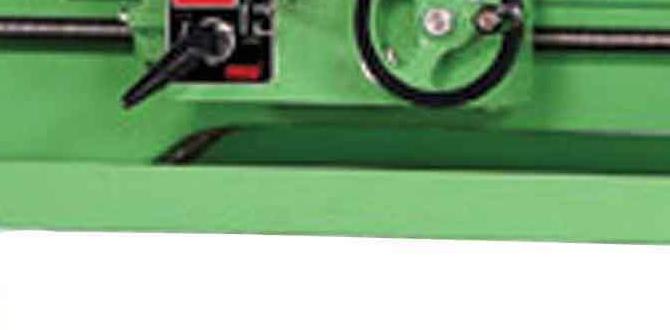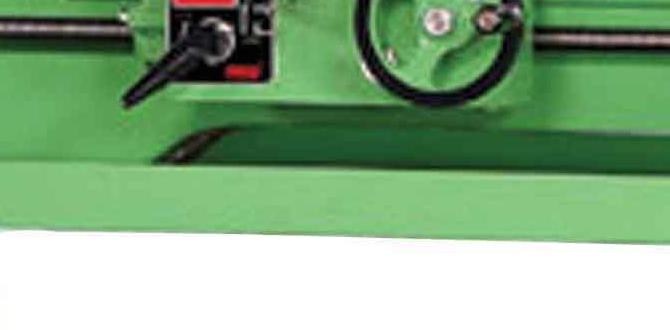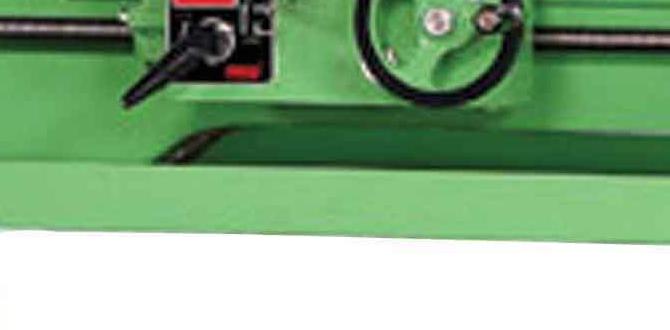Wood lathe vibration analysis is crucial for achieving smooth finishes, extending tool life, and ensuring operator safety. This guide helps beginners identify and fix common causes of excessive shaking for a better woodworking experience.
Does your wood lathe shake more than it should? You’re not alone! Many beginners find that an unsteady lathe can make turning wood a frustrating chore. Instead of getting that beautiful, smooth finish, you end up with unsightly ripples and bumps. This vibration isn’t just annoying; it can also dull your tools faster and even be a safety hazard. But don’t worry! Understanding why your lathe is vibrating and how to fix it is simpler than you might think. We’ll break down wood lathe vibration analysis step-by-step, so you can get back to turning with confidence.
Why Wood Lathe Vibration Matters
A stable wood lathe is the foundation for quality woodworking. When your lathe is properly balanced and running smoothly, you can achieve incredible results. Think of those perfectly shaped bowls, spindle work with crisp details, and finishes so smooth you can practically see your reflection. But when vibration creeps in, everything changes.
Excessive vibration can:
- Degrade Finish Quality: The cutting tool skips and chatters over the wood, leaving behind nasty ridges and an uneven surface that requires a lot of sanding.
- Damage Tools: Constant shaking puts stress on your cutting edges, causing them to dull much faster. This means more frequent sharpening and potentially higher costs.
- Reduce Accuracy: If the lathe itself is moving, it’s incredibly hard to make precise cuts. Your measurements might be off, and intricate details become a struggle.
- Increase Safety Risks: A vibrating lathe is an unstable lathe. This can lead to the workpiece coming loose, tools slipping, or even the entire machine moving unexpectedly, posing a real danger to the operator.
- Cause Operator Fatigue: Holding steady against a shaking machine is tiring. You’ll find yourself less able to concentrate on your work, leading to mistakes and a less enjoyable experience.
The good news is that most wood lathe vibrations are caused by simple, fixable issues. By learning to analyze and address these problems, you can unlock the true potential of your lathe.
Common Causes of Wood Lathe Vibration
Identifying the source of vibration is the first step to fixing it. Think of it like being a detective in your workshop. We’ll look for clues to figure out what’s making your lathe dance.
1. Workpiece Imbalance
This is by far the most common culprit, especially when starting a new piece of wood. A rough-sawn or asymmetrical blank will naturally cause the lathe to shake as it spins.
- The Problem: When the mass of the wood isn’t evenly distributed around its center of rotation, the heavier parts pull outwards, forcing the lathe to move. This is most noticeable at lower speeds but can persist even at higher ones.
- How to Identify: The vibration often starts or gets worse as soon as you turn on the lathe with a new piece. It can feel like the entire machine is being kicked around. The shaking might be more pronounced at certain points in the revolution.
- The Fix:
- Rough Turning: Before you start shaping, use a roughing gouge to turn your blank into a basic cylinder. This removes the most irregular parts of the wood, creating a more balanced shape.
- Centering: Ensure your workpiece is properly centered on the headstock and tailstock if applicable.
- Chuck Selection: Make sure your chuck is appropriate for the size and weight of the workpiece.
2. Loose Headstock or Tailstock Components
The headstock (where the motor and spindle are) and the tailstock (the part that supports the other end of the wood) need to be securely fastened.
- The Problem: If the headstock casting isn’t firmly locked onto the bed, or the tailstock isn’t tightly clamped, any force from turning will cause them to shift and vibrate.
- How to Identify: Vibration might be localized to one end of the lathe. You might hear clunking or rattling sounds as these parts move.
- The Fix:
- Headstock Mount: Check that the headstock is securely bolted to the lathe bed. Most lathes have locking levers or bolts for this purpose. Ensure they are fully engaged and tightened.
- Tailstock Clamp: Clamp the tailstock firmly to the bed. The lever that locks it should be quite stiff when tightened.
- Live Center/Drill Chuck: Ensure any accessories in the tailstock (like a live center or drill chuck) are properly seated and locked.
3. Bent Tool Rest or Banjo
The tool rest, and the banjo that holds it, are critical for supporting your turning tools. If they are not stable or aligned, they can introduce vibration.
- The Problem: A bent tool rest or a loose banjo can cause your tool to jump or feel unstable as you cut. This instability translates directly into vibration felt throughout the lathe.
- How to Identify: The vibration might feel like it’s directly related to where you are placing your tool. You might notice the tool rest itself wobbling or feeling loose.
- The Fix:
- Inspect for Bends: Visually inspect the tool rest and banjo for any obvious damage or misalignment.
- Tighten the Banjo: Ensure the banjo’s locking mechanism is tight against the lathe bed.
- Tool Rest Alignment: The top surface of the tool rest should be close to parallel with the ways (the “rails” the banjo slides on). Most lathes have a way to adjust this. Make sure the tool rest post is firmly seated in the banjo.
4. Unbalanced Drive or Spindle Components
The parts spinning at the headstock, like the pulley system or any faceplates or chucks, need to be balanced.
- The Problem: If the drive pulley, faceplate, or chuck is damaged, warped, or not mounted correctly, its unbalanced mass will cause vibration as it spins.
- How to Identify: This vibration is usually felt strongly from the headstock end and may be present even without a workpiece. It might have a distinct, rhythmic thumping or wobbling sound.
- The Fix:
- Check Pulleys: Ensure the drive pulley on the headstock is securely attached and not damaged.
- Inspect Chuck/Faceplate: Remove the chuck or faceplate and inspect it for damage. Make sure it’s mounted flush against the spindle. Try re-mounting it to ensure it’s seated properly. Look for any signs of warping or imbalance.
- Faceplate Rings: If you use faceplate rings, ensure they are not warped or damaged.
5. Issues with the Lathe Bed or Legs
The lathe’s foundation is essential for stability. Any looseness or instability here will be magnified.
- The Problem: If the lathe bed is not securely attached to its legs, or if the legs are not sitting firmly on an even surface, the whole machine can rock and vibrate.
- How to Identify: The entire lathe might feel like it’s rocking or shimmying. You might notice uneven movement when you push on the machine.
- The Fix:
- Bed-to-Leg Connections: Ensure all bolts or fasteners connecting the lathe bed to its stand or legs are tight.
- Stable Surface: Place the lathe on a level, solid floor. Floors can sometimes have a slight slope. Use shims if necessary to ensure all four legs are firmly on the ground. Avoid placing lathes on soft or flexible surfaces like rubber mats that can absorb vibration unevenly.
6. Drive Belt Tension
The belt connecting the motor pulley to the headstock pulley can affect smooth operation.
- The Problem: A belt that is too loose can slip and cause inconsistent speed, leading to vibration. A belt that is too tight can put extra strain on bearings.
- How to Identify: You might hear the belt slipping, especially under load. The speed might fluctuate unexpectedly, causing a pulsing vibration.
- The Fix:
- Adjust Tension: Most lathes have a mechanism to adjust belt tension. Consult your lathe’s manual for specific instructions. Aim for a belt that has a slight give but is not so loose that it slips. A general rule of thumb is about 1/2 inch of deflection when pressed gently.
- Inspect Belt Condition: Check the belt for wear, cracks, or damage. A damaged belt can run unevenly.
7. Out-of-Balance Rotating Assemblies (Motor or Headstock Spindle)
While less common for beginners to diagnose, sometimes the internal rotating parts themselves can be the issue.
- The Problem: If the motor’s rotor or the headstock spindle is internally unbalanced due to manufacturing defects or damage, it will create vibration at its rotational speed.
- How to Identify: This vibration is usually constant, present even at higher speeds, and originates from within the headstock or motor housing. It’s often a high-frequency vibration.
- The Fix:
- Consult Manual: Refer to your lathe’s manual. Some motors or spindles can be balanced, but it’s often a factory or repair shop job.
- Professional Service: If you suspect this is the issue, it’s best to contact the manufacturer or a qualified repair technician.
Step-by-Step Wood Lathe Vibration Analysis
Let’s put on our detective hats and go through a systematic process to pinpoint the source of your lathe’s shaking.
Step 1: Safety First! Preparation is Key.
Before you touch anything, ALWAYS disconnect the power to your lathe. Safety is paramount in any workshop. Make sure you have a clear workspace around the lathe.
Step 2: The Cold, Hard Look – Visual Inspection
Power OFF!
- Check the Workpiece: If a workpiece is mounted, is it excessively out of round? Does it look like it’s mounted off-center?
- Headstock and Tailstock: Are they firmly clamped to the bed? Wiggle them gently. Should they move? If so, tighten them.
- Tool Rest and Banjo: Is the banjo locked securely to the bed? Is the locking mechanism tight? Is the tool rest post firmly seated in the banjo?
- Bed and Legs: Do the legs sit evenly on the floor? Does the bed feel solid on its stand?
- Drive Belt: Look at the belt. Is it cracked or frayed? Does it look unusually slack?
- Chuck/Faceplate: Is the chuck or faceplate mounted correctly and securely on the spindle? Is there any visible damage?
Step 3: The Empty Lathe Test – No Workpiece
With the power OFF, double-check that everything is tight. Now, plug in the lathe, but do NOT mount any wood.
- Start at Low Speed: Turn the lathe on at its lowest speed setting. Listen and feel for any vibrations.
- Increase Speed Gradually: Slowly increase the speed. Pay attention to where the vibration seems to originate and if it changes with speed.
- Observe Headstock Components: Watch the headstock. Is the spindle running true? Is the chuck or faceplate wobbling?
- Observe Motor Area: Listen to the motor and drive system. Are there any unusual noises?
If you feel significant vibration on an empty lathe, the problem likely lies in the headstock components, the motor, the drive belt, or the lathe’s frame/legs.
Step 4: The Workpiece Wobble Test
Now, mount a balanced, cylindrical workpiece (a squared-off blank is best for this test) and secure it properly.
- Start at Low Speed: Turn the lathe on at its lowest speed.
- Rough Turn: Use a roughing gouge to turn the blank into a basic cylinder. This is crucial for removing the initial imbalance. You’ll likely feel a lot of vibration.
- Increase Speed and Refine: As you get closer to a round shape, the vibration should decrease. Increase the speed as you get the wood closer to round.
- Test Each Component:
- Tailstock Support: If you’re turning a longer piece, ensure the tailstock center is properly engaged and tight. A piece that flexes without tailstock support can cause vibration.
- Tool Rest Position: With the wood running fairly smoothly, move the tool rest closer to the workpiece. Does the vibration change? Your tool rest needs to be close enough to support the tool without being so close it contacts the wood.
If vibration is most noticeable with a workpiece, and it significantly reduces as you create a round shape, the primary issue was likely workpiece imbalance.
Step 5: Fine-Tuning Chucks and Faceplates
Chuck jaws and screw-in faceplates are common sources of vibration if not properly maintained.
- Jaw Seating: Ensure all jaws in your chuck are correctly seated in their respective channels. They should move smoothly and align properly with the body of the chuck. Even one slightly misaligned jaw can cause imbalance.
- Jaw Tightening: When mounting wood in a chuck, tighten the jaws evenly, alternating from one to the next. This ensures even pressure.
- Faceplate Threads: For screw-in faceplates, ensure the threads on both the faceplate and the lathe spindle are clean and free of debris. A faceplate that is not fully seated against the shoulder of the spindle will wobble.
- Balanced Jaws/Adapters: Some chucks have different sets of jaws or adapters. Ensure you are using the correct set and that they are securely attached.
Step 6: Aligning Your Tools and Rest
Even with a balanced lathe and workpiece, incorrect tool setup can cause chatter and vibration.
- Tool Rest Height and Angle: The top of your tool rest should be roughly level with the center of the workpiece, or slightly below. The angle for most tools is also adjusted so the cutting edge is presented correctly. Common advice is to have the tool rest slightly below center for gouges and slightly above for scrapers or parting tools. Experimentation is key here, but consistency in how you set it up matters.
- Tool Angle: How you hold your turning tool against the rest and present it to the wood is critical. A tool held at the wrong angle can dig in or skip, creating vibration.
| Symptom | Possible Cause | Quick Fix Strategy |
|---|---|---|
| Severe shaking when starting new wood, less when round. | Workpiece Imbalance. | Rough turn to cylinder; center workpiece well. |
| Lathe shakes even without wood. | Headstock/Tailstock loose, Chuck/Faceplate imbalance, Motor issue. | Check all locking levers; inspect chuck for damage; test run empty. |
| Vibration feels like it’s coming from the tailstock end. | Loose tailstock clamp, tailstock center issue. | Tighten tailstock clamp; ensure center is seated. |






